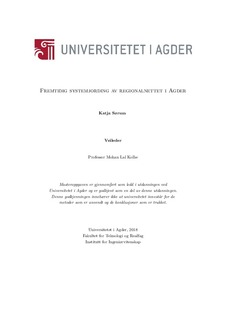| dc.contributor.author | Sørum, Katja | |
| dc.date.accessioned | 2018-09-18T09:52:23Z | |
| dc.date.available | 2018-09-18T09:52:23Z | |
| dc.date.issued | 2018 | |
| dc.identifier.uri | http://hdl.handle.net/11250/2563134 | |
| dc.description | Masteroppgave fornybar energi ENE500 - Universitetet i Agder 2018 | nb_NO |
| dc.description.abstract | System earthing describes how the neutral of a transformer is connected to ground. If a ground fault occurs, the system earthing is to detect and manage the fault current in such a way that it does not inflict damage on humans or the grid. An increasing fault current in compensated earthed networks have recently started to cause concerns in the Norwegian regional grid. Grid expansions, upgrades in operating voltage and increased amount of cables are factors that have made the fault current rise in many parts of the regional grid. Due to this, a review of possible system earthing designs has been desired, to insure a future-oriented development of power grids. In this master’s thesis, a 110 kV regional grid located in southern Norway has been investigated. Two analyses have been done to cover the grid behavior during a single- phase ground fault. In the first analysis the fault current is examined before and after an upgrade in operating voltage to 132 kV. In the second analysis a system expansion with the nearby 132 kV network is analyzed in addition to the voltage upgrade. The methods used for the analysis are based on current calculations and previous work on the subject. Numbers from the industry have been used for cost calculations, as well as results from previous investigations on similar networks in Norway. In the results the fault current was found to increase from 30 A to 40 A by upgrad- ing the operating voltage from 110 kV to 132 kV. A possible network expansion of 520 - 1192 kilometers was found when assuming no change in cable percentage. A conclusion was made that the grid should continue with compensated neutrals, as the fault current is within the maximum recommended fault current of 80 ampere. In the second analysis results showed a rise in fault current to round 80 A. Two al- ternatives were considered to reduce the fault current As suggestions for reducing the fault current galvanic isolation and a change in system earthing to solid earthing were considered and elaborated. Because dividing the network by galvanic isolation only would postpone other initiatives in reducing the increasing fault current, the alternative of changing into a solid earthed system was concluded as the most future – oriented so- lution. The total cost of voltage upgrade and change in system earthing was estimated at NOK 108 million and NOK 560 million, respectively. Costs should be assessed with a -10%/+20% margin of uncertainty. | nb_NO |
| dc.language.iso | nob | nb_NO |
| dc.publisher | Universitetet i Agder ; University of Agder | nb_NO |
| dc.rights | Attribution-NonCommercial-NoDerivatives 4.0 Internasjonal | * |
| dc.rights.uri | http://creativecommons.org/licenses/by-nc-nd/4.0/deed.no | * |
| dc.subject | ENE500 | nb_NO |
| dc.title | Fremtidig systemjording av regionalnettet i Agder | nb_NO |
| dc.type | Master thesis | nb_NO |
| dc.subject.nsi | VDP::Teknologi: 500::Elektrotekniske fag: 540::Elkraft: 542 | nb_NO |
| dc.source.pagenumber | 88 s. | nb_NO |

